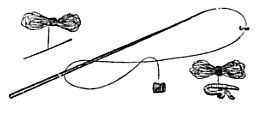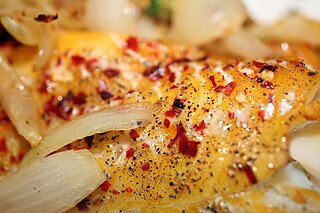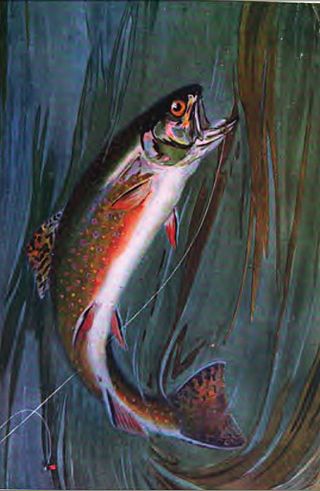Related Research Articles

A sniggle is a type of fish hook used for catching eels, using the method of sniggling.

Fly fishing is an angling technique that uses a ultralight-weight lure called an artificial fly, which typically mimics small invertebrates such as flying and aquatic insects to attract and catch fish. Because the mass of the fly lure is insufficient to overcome air resistance, it cannot be launched far using conventional gears and techniques, so specialized tackles are used instead and the casting techniques are significantly different from other forms of angling. It is also very common for the angler to wear waders, carry a hand net, and stand in the water when fishing.

The Deschutes River in central Oregon is a major tributary of the Columbia River. The river provides much of the drainage on the eastern side of the Cascade Range in Oregon, gathering many of the tributaries that descend from the drier, eastern flank of the mountains. The Deschutes provided an important route to and from the Columbia for Native Americans for thousands of years, and then in the 19th century for pioneers on the Oregon Trail. The river flows mostly through rugged and arid country, and its valley provides a cultural heart for central Oregon. Today the river supplies water for irrigation and is popular in the summer for whitewater rafting and fishing.

All Souls Church is a conservative evangelical Anglican church in central London, situated in Langham Place in Marylebone, at the north end of Regent Street. It was designed in Regency style by John Nash and consecrated in 1824.

Recreational fishing, also called sport fishing or game fishing, is fishing for leisure, exercise or competition. It can be contrasted with commercial fishing, which is professional fishing for profit; or subsistence fishing, which is fishing for survival and livelihood.

The rainbow trout is a species of trout native to cold-water tributaries of the Pacific Ocean in Asia and North America. The steelhead is an anadromous (sea-run) form of the coastal rainbow trout(O. m. irideus) or Columbia River redband trout (O. m. gairdneri) that usually returns to freshwater to spawn after living two to three years in the ocean. Freshwater forms that have been introduced into the Great Lakes and migrate into tributaries to spawn are also called steelhead.

The Devil's Grinding Mill, sometimes known as the Devil's Hole, is part of The Angel's Drainpipe, a partially collapsed cave system on the River Eden in England, which forms dramatic gorges and natural arches. It is south of Kirkby Stephen, within Stenkrith Park. The water moving with the caves and gorges produces an incessant roar. Geologically it is unusual as it has formed not in true limestone, but in brockram, a breccia of limestone fragments within sandstone.
In Scottish custom, Unspoken Water was water believed to have healing properties when collected "from under a bridge, over which the living pass and the dead are carried, brought in the dawn or twilight to the house of a sick person, without the bearer’s speaking, either in going or returning".
The Divalia was a Roman festival held on December 21, in honour of the goddess Angerona, whence it is also called Angeronalia. On the day of this festival the pontifices performed sacrifices in the temple of Voluptia, or the goddess of joy and pleasure, who, some say, was the same with Angerona, and supposed to drive away all the sorrow and chagrin of life.

Fly tying is the process of producing an artificial fly used by fly fishing anglers to catch fish. Fly tying is a manual process done by a single individual using hand tools and a variety of natural and manmade materials that are attached to a hook. Although the recent history of fly tying dates from the middle 1800s, fly tyers were engaged in tying flys since at least 200 AD.
Trout tickling is the art of rubbing the underbelly of a trout with fingers. If done properly, the trout will go into a trance after a minute or so, and can then easily be retrieved and thrown onto the nearest bit of dry land.

Finnan haddie is cold-smoked haddock, representative of a regional method of smoking with green wood and peat in north-east Scotland.

The leopard coral grouper, also known as the common coral trout, leopard coral trout, blue-dotted coral grouper or spotted coral grouper, is a species of marine ray-finned fish, a grouper from the subfamily Epinephelinae which is part of the family Serranidae, which also includes the anthias and sea basses. It is found in the Western Pacific Ocean.

Fishing techniques are methods for catching fish. The term may also be applied to methods for catching other aquatic animals such as molluscs and edible marine invertebrates.
The Kaleidoscope; or, Literary and Scientific Mirror was an English weekly published between 1818 and 1831 by the Liverpool publisher Egerton Smith (1774–1841), who had established the Liverpool Mercury in 1811. The magazine's name was taken from David Brewster's recent invention. The first number appeared on 28 July 1818 in folio form; two years later the publication became an eight-page quarto. The price was kept at threepence-halfpenny throughout the magazine's history.

This general annotated bibliography page provides an overview of notable and not so notable works in the English language regarding the sport of fly fishing, listed by year of first publication. Although not all the listed books are devoted exclusively to fly fishing, all these titles contain significant fly fishing content. The focus of the present page is on classic general texts on fly fishing and its history, together with notable public or university library collections dedicated to fly fishing.

Blacker's Art of Fly Making - comprising angling and dyeing of colours with engravings of Salmon and Trout flies shewing the process of the gentle craft as taught in the pages with descriptions of flies for the season of the year as they come out on the water is a work of fly tying literature with significant fly fishing content written by William Blacker, a London tackle dealer and first published in London in 1842 by George Nichols. The 1842 and 1843 editions were only 48 pages while, the 1855 edition was considerably expanded by Blacker with hand-painted, colored illustrations and 252 pages.

This annotated bibliography is intended to list both notable and not so notable works of English language, non-fiction and fiction related to the sport of fly fishing listed by year published. Although 100% of any book listed is not necessarily devoted to fly fishing, all these titles have significant fly fishing content. Included in this bibliography is a list of species related fly fishing literature.
Edward Lapidge (1779–1860) was an English architect, who held the post of county surveyor of Surrey and designed Kingston Bridge.

Giovanni Battista Lusieri (1755–1821) was an Italian landscape painter from Naples. He was court painter to Ferdinand I of the Two Sicilies before working for Thomas Bruce, 7th Earl of Elgin and becoming involved in the removal and shipping of the Elgin Marbles to England.
References
- ↑ W.H.H. (August 23, 1828) "'Trout-binning' in West-Moreland." The Mirror of Literature, Amusement, and Instruction12:328, pp 116-117. Viewed July 25, 2014.

